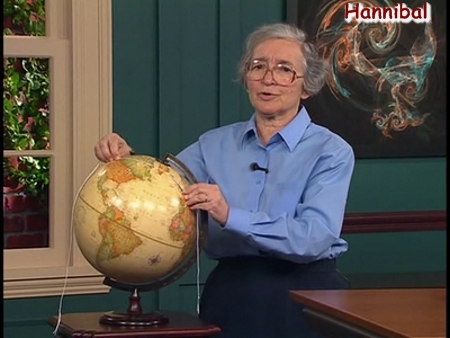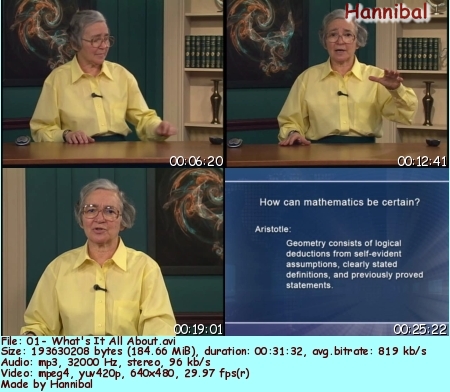
TTC - Judith Grabiner - Mathematics, Philosophy, and the 'Real World'
English | eLearning - DVDRip | 640х480 | Run time: ~36 x 30 min | 6.5 GB
Mathematics has spread its influence far beyond the realm of numbers. The concepts and methods of mathematics are crucially important to all of culture and affect the way countless people in all spheres of life look at the world.
Consider these cases:
• When Leonardo da Vinci planned his mural The Last Supper in the 1490s, he employed geometric perspective to create a uniquely striking composition, centered on the head of Jesus.
• When Thomas Jefferson sat down to write the Declaration of Independence in 1776, he composed it on the model of a geometric proof, which is what gives it much of its power as a defense of liberty.
• When Albert Einstein developed his theory of general relativity in the early 20th century, he used non-Euclidean geometry to prove that the path of a ray of light, in the presence of a gravitational field, is not straight but curved.
Mathematics, Philosophy, and the "Real World" introduces enough elementary probability and statistics so that you understand the subtleties of the all-important bell curve. Then you are immersed in key theorems of Euclid's Elements of Geometry, the 2,200-year-old work that set the standard for logical argument. Throughout the course, Professor Grabiner shows how these fundamental ideas have had an enormous impact in other fields. Notably, mathematics helped stimulate the development of Western philosophy and it has guided philosophical thought ever since, a role that you investigate through thinkers such as these:
• Plato: Flourishing in the 4th century B.C.E., Plato was inspired by geometry to argue that reality resides in a perfect world of Forms accessible only to the intellect—just like the ideal circles, triangles, and other shapes that seem to exist only in the mind.
• Descartes: Writing in the 17th century, Rene Descartes used geometric reasoning in a systematic search for all possible truths. In a famous exercise, he doubted everything until he arrived at an irrefutable fact: "I think, therefore I am."
• Kant: A century after Descartes, Immanuel Kant argued that metaphysics was possible by showing its kinship with mathematics. The perfection of Euclidean geometry led him to take for granted that space has to be Euclidean.
• Einstein: Working in the early 20th century with a concept of "straight lines" that was different from Euclid's, Albert Einstein showed that gravity is a geometric property of non-Euclidean space, which is an essential idea of his general theory of relativity.
Non-Euclidean Geometry Explained
The discovery of non-Euclidean geometry influenced fields beyond mathematics, laying the foundation for new scientific and philosophical theories and also inspiring works by artists such as the Cubists, the Surrealists, and their successors leading up to today.
Non-Euclidean geometry was a stunning intellectual breakthrough in the 19th century, and you study how three mathematicians, working independently, overthrew the belief that Euclid's geometry was the only possible consistent system for dealing with points, lines, surfaces, and solids. Einstein's theory of relativity was just one of the many ideas to draw on the non-Euclidean insight that parallel lines need not be the way Euclid imagined them.
Mathematics has not only changed the way specialists think about the world, it has given the rest of us an easily understandable set of concepts for analyzing and understanding our surroundings. Professor Grabiner provides a checklist of questions to ask about any statistical or probabilistic data that you may encounter. Her intriguing observations include the following:
• Statistics: Biologist and author Stephen Jay Gould, who developed abdominal cancer, was told his disease had an eight-month median survival time after diagnosis. The diagnosis sounded hopeless, but his understanding of the characteristics of the median (as opposed to the mean or mode) gave him a strategy for survival.
• Bad graphs: There are many ways to make a bad graph; some deliberately misleading, others merely badly conceived. Beware of a graph that starts at a number higher than zero, since comparisons between different data points on the graph will be exaggerated.
• Polls: The Literary Digest poll before the 1936 U.S. presidential election was the largest ever conducted and predicted a landslide win for Alf Landon over Franklin Roosevelt. Yet the result was exactly the opposite due to an unrecognized systematic bias in the polling sample.
• Probability: Intuition can lead one astray when one is judging probabilities. You investigate the case of an eyewitness to an accident who has done well on tests of identifying the type of vehicle involved. But a simple calculation shows that she is more likely wrong than not.
professor : Judith V. Grabiner
production land: USA
Run time: ~36 x 30 min
01 - What's It All About
02 - You Bet Your Life—Statistics and Medicine
03 - You Bet Your Life—Cost -Benefit Analysis
04 - Popular Statistics—Averages and Base Rates
05 - Popular Statistics—Graphs
06 - Popular Statistics—Polling and Sampling
07 - The Birth of Social Statistics
08 - Probability, Multiplication, and Permutations
09 - Combinations and Probability Graphs
10 - Probability, Determinism, and Free Will
11 - Probability Problems for Fun and Profit
12 - Probability and Modern Science
13 - From Probability to Certainty
14 - Appearance and Reality—Plato's Divided Line
15 - Plato's Cave —The Nature of Learning
16 - Euclid's Elements—Background and Structure
17 - Euclid's Elements—A Model of Reasoning
18 - Logic and Logical Fallacies—Why They Matter
19 - Plato's Meno—How Learning Is Possible
20 - Plato's Meno—Reasoning and Knowledge
21 - More Euclidean Proofs, Direct and Indirect
22 - Descartes—Method and Mathematics
23 - Spinoza and Jefferson
24 - Consensus and Optimism in the 18th Century
25 - Euclid—Parallels, Without Postulate 5
26 - Euclid—Parallels, Needing Postulate 5
27 - Kant, Causality, and Metaphysics
28 - Kant's Theory of Space and Time
29 - Euclidean Space, Perspective, and Art
30 - Non -Euclidean Geometry—History and Examples
31 - Non -Euclidean Geometries and Relativity
32 - Non -Euclidean Geometry and Philosophy
33 - Art, Philosophy, and Non -Euclidean Geometry
34 - Culture and Mathematics in Classical China
35 - The Voice of the Critics
36 - Mathematics and the Modern World
TTC - Judith Grabiner - Mathematics, Philosophy, and the 'Real World'
Post a Comment
Bannerad
Artikel Terpopuler
-
2016-08-09 18:38:19.0 Guangzhou Int'l Parcel Center received 2016-08-09 18:38:25.0 Guangzhou Int'l Parcel Center customs scan 20...
-
Despite that at the end of this post you will find a filtered and somehow manually edited list of Pligg-based social bookmarking sites, this...
-
Twitter pages have their own google page rank too in Google, so it is important to do that 5 mins drill better utilize your Twitter page.Thi...
-
PicPick is an all-in-one software for software developers, graphic designers and home user. It has an intuitive interface and simple, elega...
-
About the author henkhei is man in the mirror where you can find everywhere henkhei . he specializes in topics of interest to techno gee...
-
Disaat-saat tertentu untuk menghilangkan kejenuhan kadang kala entertain (kesenangan) harus kita upayakan, demikian pula ketika kita berkuta...
-
A tablet PC is a wireless, portable personal computer with a touch screen interface. The tablet form factor is typically smaller than ...
-
It seems the method for us to use is far simpler than my initial impressions - we need only add two small sections of code to our templates ...
-
search text across multiple files with Windows Grep Windows only: Windows Grep searches user-defined files and folders for text or regular e...
-
Looking for the ultimate tips for Google searching? You've just found the only guide to Google you need. Let's get started: 1. The b...
Tags
Blogumulus by Roy Tanck and Amanda Fazani

